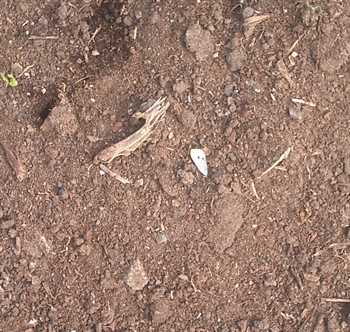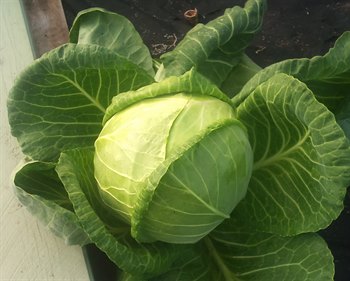To Spray or Not To Spray
Do I spray? That is the constant question running through the mind of the home gardener. On the one hand is the want to grow organic produce without the use of chemicals and fungicides. Deep inside there is an intuitive knowledge that tells the farmer that all the sprays and chemicals that are produced for use in controlling bugs and disease are not doing the gardener any good healthwise and are contributing to the ruination of the earth’s eco-system.
But the pain the gardener goes through when crops are disfigured by insect attack or fungal attack drive him to think about what chemicals he could use to alleviate the problem. It certainly can’t be cured with chemicals, just alleviated, and in the process an addiction to chemicals is created within the gardener.
What’s the difference between this cabbage and the one beside it?
The only difference between the two cabbages is a screen around the wicking bed that keeps the insects out.
Protected crops are, in my opinion, the most effective way to grow produce and to produce quality crops that look as good as any produce grown with conventional farming methods. The biggest stumbling block for organic farming is the consumers desire to have a perfect looking piece of fruit or vegetable. Nothing else matters.
It is quite enlightening to stand in the fruit and veg section of the supermarket and watch how people pick over their choice of which one to take. Beauty is in the eye of the beholder, but I know if I have the choice between the cabbages, I will pick the cabbage without the blemishes.
So what’s the solution for growing without the use of Chemicals?
 Protected crops are definitely one solution. Not only from insects but also weather. Hail, flooding rain, excessive heat and insects can all be eliminated from the growing equation. Have a look at Cravo houses from Canada.
Protected crops are definitely one solution. Not only from insects but also weather. Hail, flooding rain, excessive heat and insects can all be eliminated from the growing equation. Have a look at Cravo houses from Canada.
These are my favourite style of protection houses as they cater mainly for crops grown in the ground. Their cost per sqm is less than glasshouses or plastic houses. Their houses have been in Australia for over seventeen years.
These houses have an opening roof and sides, which makes it more susceptible to pest pressure. The benefits of the protection still help and with the sides closed, they have found that insect numbers are reduced considerably as the majority stay closer to the ground where they have more chance of finding food and protection rather than being in the open for keen eyed birds and other predators.
What about Sundrop Farms?
 Go and have a look at them on Google Maps. Just put Sundrop Farms Port Augusta into the search bar of Maps and have a look at what comes up. If that’s not enough, go to their website. They’ve used a drone to take some magnificent aerials of their site which includes the glasshouses, their 20ha solar array and capture tower, water collection and site. It is quite mesmerising.
Go and have a look at them on Google Maps. Just put Sundrop Farms Port Augusta into the search bar of Maps and have a look at what comes up. If that’s not enough, go to their website. They’ve used a drone to take some magnificent aerials of their site which includes the glasshouses, their 20ha solar array and capture tower, water collection and site. It is quite mesmerising.
The following is an extract from their website
An everlasting supply of sunshine and sea water to grow food in arid lands
If you are a traditional farmer, you’ll need water and energy to grow your produce. And you’ll need lots of it.
The challenge is that they are finite resources that are becoming ever scarcer. Our solution? Not to use them!
We don’t extract groundwater from the planet at unsustainable rates. We don’t rely on fossil fuels. And we don’t use soil or valuable farmlands.
Instead we’ve developed technologies that integrate solar power, electricity generation, fresh water production and hydroponics. It produces an equivalent quantity of food to that grown using traditional methods, but the quality is significantly better.
Costa Farms Guyra
 Another modern facility that is 20ha under glass in Guyra, near Armidale in NSW. The glass houses offer weather protection as much as anything and the location ensures a cold winter. A cold winter is a godsend for releiving pest pressue. Insects prefer the warmth.
Another modern facility that is 20ha under glass in Guyra, near Armidale in NSW. The glass houses offer weather protection as much as anything and the location ensures a cold winter. A cold winter is a godsend for releiving pest pressue. Insects prefer the warmth.
There are many more large glass and poly house areas throughout Australia. Originally they were built to extend the growing season and for cold protection. Now they are protecting crops in numerous ways. Combining the capital expenditure with hydroponics means big companies can get a great return on their investment as they don’t have to worry about crop rotation and fallow periods to replenish their soil.
 Here in Brisbane, Queensland we don’t get much of a break. I am writing this on the 6th July and the temperature today was over 25 degrees C. I happened to kill a white cabbage moth with a backhand shot using an old squash racket.
Here in Brisbane, Queensland we don’t get much of a break. I am writing this on the 6th July and the temperature today was over 25 degrees C. I happened to kill a white cabbage moth with a backhand shot using an old squash racket.
I’m still waiting for the cold snap that sorts the insects out and gives me a break from them. August and early September should see some cold snaps though.
From what I can see the future for intensive agriculture is going to be in protected houses or in factories. With the advent of low cost LED lighting that can be broadcast in any frequency of the spectrum best suited for photosynthesis we will see old factory areas close to major cities get repurposed as farms.
Hydroponic and aeroponic systems will be the preferred growing method.
Call me old fashioned but I still prefer the system that was developed without our input that we seem hellbent on destroying. Growing in the dirt and looking after the soil food web is still, hands down, the best system for growing vegetables.
This doesn’t mean my opinion won’t change over time. I can see vast increases in the quality and shelf life of hydroponically grown produce. And let’s face it, how are we going to get off planet unless we have a system for feeding ourselves.
That’s right machines don’t need nutrients like humans.



